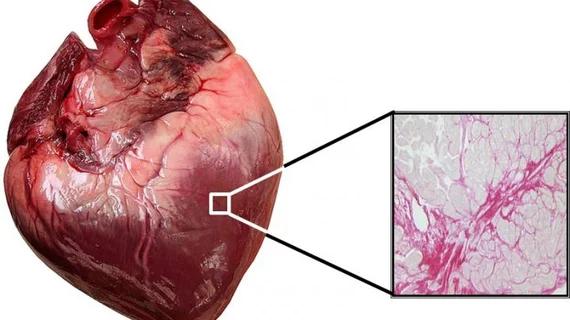Cardiac amyloidosis remains underreported in US
Twice as many U.S. deaths due to cardiac amyloidosis were reported in 2015 than in 1979, but a study in JAMA Cardiology suggests the disease remains vastly underdiagnosed.
Lead author Kevin M. Alexander, MD, and colleagues arrived at this conclusion after finding the counties near amyloidosis centers had the highest death rates attributed to the condition. Also, southern states had relatively low diagnosis rates, despite the fact black people—who disproportionately inhabit the South—had the highest incidence of amyloidosis mortality.
Cardiac amyloidosis occurs when deposits of the amyloid protein affect the heart tissue, which can stiffen and thicken the muscle and impair its function.
“The clustering of mortality in regions with amyloidosis centers and the lack of higher reported mortality rates in states with a greater proportion of black residents support possible underdiagnosis of cardiac amyloidosis in these regions,” Alexander et al. wrote. “Future studies are warranted to better understand these disparities in reported amyloidosis mortality.”
The researchers analyzed death certificates from a Centers for Disease Control and Prevention (CDC) database and identified 30,764 individuals with amyloidosis listed as the underlying cause of death from 1979 to 2015. Another 27,312 had the disease listed as a contributing cause of death.
From 1979 to 2015, the rates of death with amyloidosis as the underlying cause more than doubled from 1.77 to 3.96 per 1,000,000 people. Incidence was highest among black men (12.36 per one million people) followed by black women (6.48 per million).
“Wild-type transthyretin cardiomyopathy is responsible for a significant, under-recognized heart failure burden in black individuals and warrants targeted interventions,” the authors wrote. “Approximately 3 to 4 percent of black individuals carry the amyloidogenic transthyretin gene mutation (valine-to-isoleucine substitution at codon 122), which confers higher lifetime risk of heart failure.”
Alexander and colleagues pointed out the five counties with the highest reported amyloidosis mortality were all located less than 400 kilometers (about 248 miles) from an amyloidosis referral center. The areas around the Mayo Clinic in Rochester, Minnesota, and Boston University—the two oldest amyloidosis centers in the country—had the first and third highest death rates attributed to the disease.
Increased testing for cardiac amyloidosis could uncover more of these cases and reduce the regional variation in diagnosis, the authors suggested. Echocardiography demonstrating a specific longitudinal strain pattern could signal the disease, along with advanced imaging techniques such as cardiac magnetic resonance with T1 mapping, positron emission tomography and technetium-99m pyrophosphate imaging.

